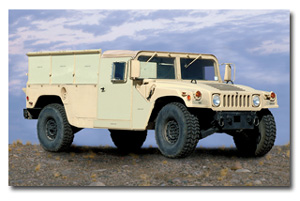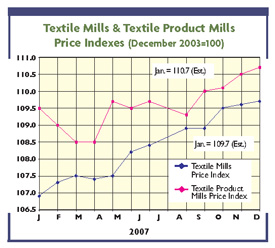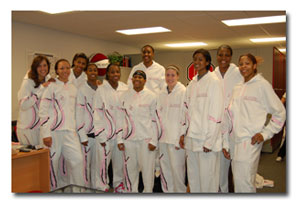T
echnical textiles continue to capture the imagination of US textile producers — and for
good reason. In conversations with
Textile World
editors, it seems that the constant buzz is about companies that are blending traditional
textile manufacturing with very creative solutions to move down a new road in textiles and
nonwovens.
It’s the first time, as reported by
TW
’s Robert Reichard in the 2008 economic forecast, that the three divisions of US Bureau of
Labor Statistics data tracking textile employment — textile mill, textile mill product and apparel
employment — have converged, with each sector employing between 150,000 and 200,000 workers. This
is significant because apparel employment has fallen roughly 70 percent and textile mill jobs have
fallen roughly 60 percent in the last 10 years. Textile mill jobs are the traditional jobs —
spinners, weavers, knitters and so forth — where the end product is still a textile building block
for the next business in the supply chain. And then, there are textile mill products that use the
output of textile mills to make a consumable product and often include what are considered
technical textiles; and from an employment standpoint, they have held on rather steadily for the
last 10 years.
The last decade has seen a major readjustment for US textiles, and some believe the worst is
over. Built on a bedrock of innovation; value-added focus; and lower volume, high-margin products —
today’s US textile industry is much different from the industry many of
TW
’s staff and readers knew early in their careers. It’s faster, more creative, less wasteful
and leanly efficient.
Machinery manufacturers understand the changes and, rather than putting all of their eggs in
the China basket, see the need to commercialize new technology that supports the US industry’s
drive into technical textiles. Machinery companies are embracing the development of durable
nonwovens and the of blending traditional textile finishing techniques that can add improved hand
and performance to an innovative nonwoven product.
Whether it is making a better bandage, made from bamboo and glass, by collaborating with
partners outside of traditional textiles (See “Not Your Run-Of-The-Mill Bandage,” March/April
2008), or developing better composite structures to shield military vehicles from deadly improvised
explosive devices in Iraq (See “Armored Up With Textiles,” March/April 2008), there is no denying
the new direction and new possibilities for textiles these creations demonstrate.
Are there challenges? You bet. The falling US dollar makes US exports inexpensive overseas,
but virtually every facet of US manufacturing costs is on the rise — from raw materials to
transportation, utilities, European machinery — the list goes on. And, of course, just try to pass
these costs along to the customer. For those in non-commodity businesses, pricing power may be a
bit stronger, but challenges will persist.
The year 2008 presents interesting opportunities. Uncertainty abounds, but US textiles have
an advantage. We’ve already survived more than most industries could bear. Successful companies
today are looking beyond traditional textiles for the answer and, if all goes well, making
innovation pay off.
March/April 2008



 The North Carolina State University (NCSU) College of Textiles, Raleigh, N.C.,
The North Carolina State University (NCSU) College of Textiles, Raleigh, N.C.,


